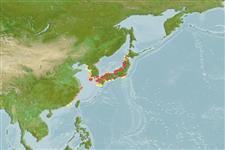Issue
Acanthogobius stigmothonus (Richardson, 1845) is considered as valid (from the South China Sea and Gulf of Tonkin) in Shibukawa & Iwata, 2013 (Ref. 93271).
Environment: milieu / climate zone / depth range / distribution range
Ecologia
marino; acqua dolce; salmastro demersale; amfidromo (Ref. 51243); distribuzione batimetrica 1 - 6 m (Ref. 96339). Temperate; 52°N - 23°N, 116°E - 143°E
Northwest Pacific: Russian Far East (from Amur to Peter the Great Gulf), Korean Peninsula, Bohai Sea, Yellow Sea and East China Sea of China, and Hokkaido to Kyushu of Japan.
Length at first maturity / Size / Peso / Age
Maturity: Lm 27.0 range ? - ? cm
Max length : 30.0 cm TL maschio/sesso non determinato; (Ref. 2850); common length : 14.5 cm TL maschio/sesso non determinato; (Ref. 12193)
Inhabits muddy and sandy bottoms along the shore of bays and estuaries, sometimes ascends rivers. Intertidal to at least 6.5 m (Ref. 96339). Oviparous, spawn in winter to early spring (Ref. 205). Eggs are deposited in Y-shaped nests (Ref. 205). Used in Chinese medicine (Ref. 12166).
Eggs are deposited near the base of the Y-shaped nest (Ref. 51058).
Shibukawa, K. and A. Iwata, 2013. Review of the East Asian gobiid genus Chaeturichthhys (Teleostei: Perciformes: Gobioidei), with description of a new species. Bull. Nat. Mus. Nat. Sci. Ser. A., Suppl. 7:53-66. (Ref. 93271)
IUCN Red List Status (Ref. 130435)
Threat to humans
Harmless
Human uses
Pesca: commerciale; Acquario: Acquari pubblici
Strumenti
Special reports
Download XML
Fonti Internet
Estimates based on models
Preferred temperature (Ref.
123201): 12 - 21.6, mean 17.9 °C (based on 189 cells).
Phylogenetic diversity index (Ref.
82804): PD
50 = 0.5156 [Uniqueness, from 0.5 = low to 2.0 = high].
Bayesian length-weight: a=0.00692 (0.00373 - 0.01284), b=3.01 (2.85 - 3.17), in cm total length, based on LWR estimates for this species & (Sub)family-body (Ref.
93245).
Trophic level (Ref.
69278): 3.4 ±0.3 se; based on diet studies.
Generation time: 3.5 ( na - na) years. Estimated as median ln(3)/K based on 1
growth studies.
Resilienza (Ref.
120179): Medio, tempo minimo di raddoppiamento della popolazione 1.4 - 4.4 anni (Preliminary K or Fecundity.).
Fishing Vulnerability (Ref.
59153): Low to moderate vulnerability (33 of 100).
